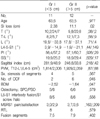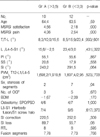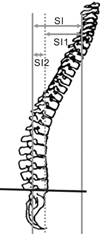1. Doherty JH. Complication of fusion in lumbar scoliosis. J Bone Joint Surg Am. 1973. 55:438–449.
2. Jansen RC, Van Rhijn LW, Van Ooij A. Predictable correction of the unfused lumbar lordosis after thoracic correction and fusion in scheuermann kyphosis. Spine. 2006. 31:1227–1231.

3. Kang CH, Shin MJ, Kim SM, Lee SH, Lee CS. MRI of paraspinal muscles in lumbar degenerative kyphosis patients and control patients with chronic low back pain. Clinical Radiology. 2007. 62:479–486.

4. Kim EH, Han SK, Kim HJ. A clinical analysis of surgical treatment of lumbar degenerative kyphosis. J Korean Soc Spine Surg. 2001. 8:210–218.

5. Kim EH, Kim SW. Anterior and posterior surgical treatment with wedged cage (SynCage®) in lumbar degenerative kyphosis. J Korean Spine Surg. 2003. 10:240–247.

6. Kim YJ, Bridwell KH, Lenke LG, Rhim S, Cheh G. Sagittal thoracic decompensation following long adult lumbar spinal instrumentation and fusion to L5 or S1: causes, prevalence, and risk factor analysis. Spine. 2006. 31:2359–2366.

7. Lee CS, Chung SS, Chung KH, Kim SR. Significance of pelvic incidence in the development of abnormal sagittal alignment. J Korean Orthop Assoc. 2006. 41:274–280.

8. Lee CS, Kim YT, Kim E. Clinical study of lumbar degenerative kyphosis. J Korean Spine Surg. 1997. 4:27–35.
9. Lee CS, Lee CK, Kim YT, Hong YM, Yoo JH. Dynamic sagittal imbalance of the spine in degenerative flat back: significance of pelvic tilt in surgical treatment. Spine. 2001. 26:2019–2035.
10. Shufflebarger H, Suk SI, Mardjetko S. Debate: determining the upper instrumented vertebra in the management of adult degenerative scoliosis: stopping at T10 versus L1. Spine. 2006. 31:Suppl 19. S185–S194.
11. Takemitsu Y, Harada Y, Iwahara T, Miyamoto M, Mitatake Y. Lumbar degenerative kyphosis. Clinical, radiological and epidemiological studies. Spine. 1988. 13:1317–1326.










 PDF
PDF ePub
ePub Citation
Citation Print
Print




 XML Download
XML Download